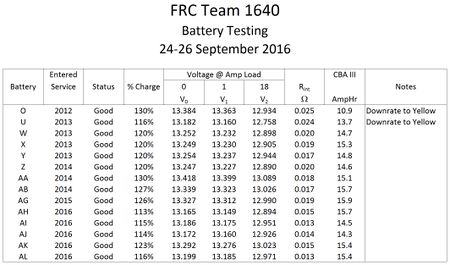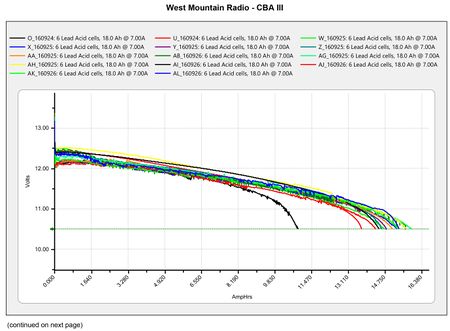Difference between revisions of "Talk:DEWBOT XII Havoc"
MaiKangWei (talk | contribs) |
MaiKangWei (talk | contribs) (→Battery Testing) |
||
| Line 1: | Line 1: | ||
==Battery Testing== | ==Battery Testing== | ||
| − | + | Driving issues during early HAVOC matches led us to fully retest our batteries. As the most recent tests were in April, this retesting was due. Our driving problems turned out to be drive-train related, not due to batteries. | |
| − | + | All competition-rated batteries were tested 24-26 September using the CBA III (manufactured by Optim Engineering - marketed and sold by West Mountain Radio). The CBA measures the voltage of a battery over time under a fixed current load until a set terminal voltage is reached. For this testing, the load is set to 7.0 amps (should have been 7.5 - this was an exception to standard procedure); terminal voltage to 10.5 volts. The CBA reports Amp Hrs. | |
[[image:Battery_Test_160924.jpg|450px|right]]The data collected on the batteries is here (right): | [[image:Battery_Test_160924.jpg|450px|right]]The data collected on the batteries is here (right): | ||
| Line 9: | Line 9: | ||
[[image:Batteries_160924.jpg|450px|left]] | [[image:Batteries_160924.jpg|450px|left]] | ||
| − | + | One battery, "O" (our oldest) was found to have sub-par performance. "O" had already been identified as problematic and was not brought to HAVOC, and so did not contribute to problems. In addition, "U" (the next oldest) is beginning to degrade and will be rerated as Yellow (not competition) as well, so as to avoid troubles. | |
Read the full [[media:U-AJ-160420.pdf | CBA III Report]]. | Read the full [[media:U-AJ-160420.pdf | CBA III Report]]. | ||
| − | Our last full battery test with the CBA III was conducted in | + | Our last full battery test with the CBA III was conducted in April 2016. These test are labor and time intensive. Since then, we have relied on the Battery Beak to assess battery health. |
Key findings of this test are: | Key findings of this test are: | ||
Revision as of 23:06, 28 September 2016
Battery Testing
Driving issues during early HAVOC matches led us to fully retest our batteries. As the most recent tests were in April, this retesting was due. Our driving problems turned out to be drive-train related, not due to batteries.
All competition-rated batteries were tested 24-26 September using the CBA III (manufactured by Optim Engineering - marketed and sold by West Mountain Radio). The CBA measures the voltage of a battery over time under a fixed current load until a set terminal voltage is reached. For this testing, the load is set to 7.0 amps (should have been 7.5 - this was an exception to standard procedure); terminal voltage to 10.5 volts. The CBA reports Amp Hrs.
The data collected on the batteries is here (right):And the CBA III performance charts (below):
One battery, "O" (our oldest) was found to have sub-par performance. "O" had already been identified as problematic and was not brought to HAVOC, and so did not contribute to problems. In addition, "U" (the next oldest) is beginning to degrade and will be rerated as Yellow (not competition) as well, so as to avoid troubles.
Read the full CBA III Report.
Our last full battery test with the CBA III was conducted in April 2016. These test are labor and time intensive. Since then, we have relied on the Battery Beak to assess battery health.
Key findings of this test are:
- The Battery Beak does not identify all failed batteries. As a result, reliance on the Battery Beak alone exposes the team to battery failures in competition (as at Westtown & MAR Championships).
- The CBA III does appear to correctly identify failed batteries (as identified by competition failures) which the Battery Beak misses.
- The CBA III appears to also identify failing batteries (such as "AE"), allowing these to be removed from competition service prior to obvious failure.
- It is clear that the team should reinstitute a regular CBA testing regime.
The CBA III is no longer manufactured. The team has ordered a CBA IV from West Mountain Radio. This augments rather than replaces the old CBA III (with is compatible with Windows 10). The team has also ordered two replacement batteries to be delivered to our pit at FRC Championship.

